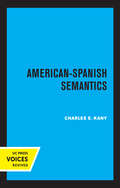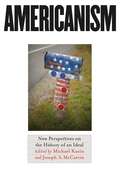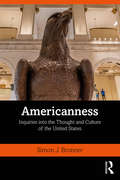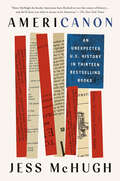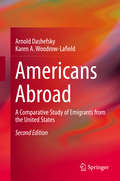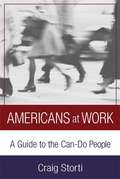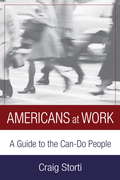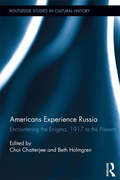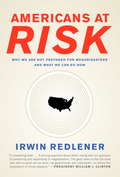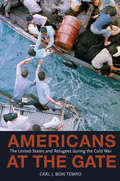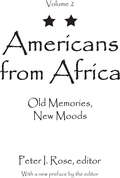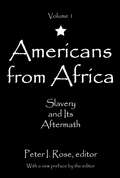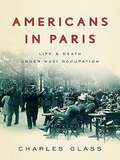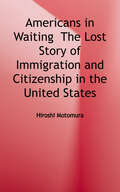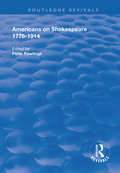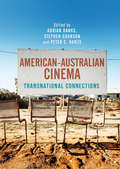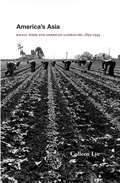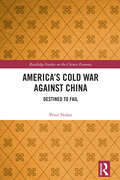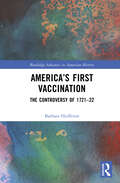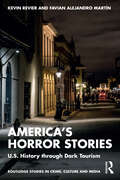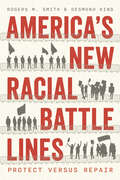- Table View
- List View
American-Spanish Semantics
by Charles E. KanyThis title is part of UC Press's Voices Revived program, which commemorates University of California Press’s mission to seek out and cultivate the brightest minds and give them voice, reach, and impact. Drawing on a backlist dating to 1893, Voices Revived makes high-quality, peer-reviewed scholarship accessible once again using print-on-demand technology. This title was originally published in 1960.
Americanism
by Michael Kazin Joseph A. MccartinWhat is Americanism? The contributors to this volume recognize Americanism in all its complexity--as an ideology, an articulation of the nation's rightful place in the world, a set of traditions, a political language, and a cultural style imbued with political meaning. In response to the pervasive vision of Americanism as a battle cry or a smug assumption, this collection of essays stirs up new questions and debates that challenge us to rethink the model currently being exported, too often by force, to the rest of the world.Crafted by a cast of both rising and renowned intellectuals from three continents, the twelve essays in this volume are divided into two sections. The first group of essays addresses the understanding of Americanism within the United States over the past two centuries, from the early republic to the war in Iraq. The second section provides perspectives from around the world in an effort to make sense of how the national creed and its critics have shaped diplomacy, war, and global culture in the twentieth and twenty-first centuries. Approaching a controversial ideology as both scholars and citizens, many of the essayists call for a revival of the ideals of Americanism in a new progressive politics that can bring together an increasingly polarized and fragmented citizenry.Contributors:Mia Bay, Rutgers UniversityJun Furuya, Hokkaido University, JapanGary Gerstle, University of MarylandJonathan M. Hansen, Harvard UniversityMichael Kazin, Georgetown UniversityRob Kroes, University of AmsterdamMelani McAlister, The George Washington UniversityJoseph A. McCartin, Georgetown UniversityAlan McPherson, Howard UniversityLouis Menand, Harvard UniversityMae M. Ngai, University of ChicagoRobert Shalhope, University of OklahomaStephen J. Whitfield, Brandeis UniversityAlan Wolfe, Boston CollegeWhat is Americanism? The contributors to this volume recognize Americanism in all its complexity--as an ideology, an articulation of the nation's rightful place in the world, a set of traditions, a political language, and a cultural style imbued with political meaning. In response to the pervasive vision of Americanism as a battle cry or a smug assumption, this collection of essays stirs up new questions and debates that challenge us to rethink the model currently being exported, too often by force, to the rest of the world.Approaching a controversial ideology as both scholars and citizens, many of the essayists call for a revival of the ideals of Americanism in a new progressive politics that can bring together an increasingly polarized and fragmented citizenry. The contributors are Mia Bay, Jun Furuya, Gary Gerstle, Jonathan M. Hansen, Michael Kazin, Rob Kroes, Melani McAlister, Joseph A. McCartin, Alan McPherson, Louis Menand, Mae M. Ngai, Robert Shalhope, Stephen J. Whitfield, and Alan Wolfe. The editors are Michael Kazin and Joseph A. McCartin.-->
Americanism in the Twenty-First Century
by Deborah J. SchildkrautThis book explores public opinion about being and becoming American, and its implications for contemporary immigration debates. It focuses on the causes and consequences of two aspects of American identity: how people define being American and whether people think of themselves primarily as American rather than as members of a panethnic or national origin group. Importantly, the book evaluates the claim - made by scholars and pundits alike - that all Americans should prioritize their American identity instead of an ethnic or national origin identity. It finds that national identity within American democracy can be a blessing or a curse. It can enhance participation, trust, and obligation. But it can be a curse when perceptions of deviation lead to threat and resentment. It can also be a curse for minorities who are attached to their American identity but also perceive discrimination. The notion of American identity is a predisposition that the government has good reason to cultivate, but also good reason to approach with caution.
Americanism: The Fourth Great Western Religion
by David GelernterWhat does it mean to "believe" in America? Why do we always speak of our country as having a mission or purpose that is higher than other nations? Modern liberals have invested a great deal in the notion that America was founded as a secular state, with religion relegated to the private sphere. David Gelernter argues that America is not secular at all, but a powerful religious idea--indeed, a religion in its own right. Gelernter argues that what we have come to call "Americanism" is in fact a secular version of Zionism. Not the Zionism of the ancient Hebrews, but that of the Puritan founders who saw themselves as the new children of Israel, creating a new Jerusalem in a new world. Their faith-based ideals of liberty, equality, and democratic governance had a greater influence on the nation's founders than the Enlightenment. Gelernter traces the development of the American religion from its roots in the Puritan Zionism of seventeenth-century New England to the idealistic fighting faith it has become, a militant creed dedicated to spreading freedom around the world. The central figures in this process were Abraham Lincoln, Teddy Roosevelt, and Woodrow Wilson, who presided over the secularization of the American Zionist idea into the form we now know as Americanism. If America is a religion, it is a religion without a god, and it is a global religion. People who believe in America live all over the world. Its adherents have included oppressed and freedom-loving peoples everywhere--from the patriots of the Greek and Hungarian revolutions to the martyred Chinese dissidents of Tiananmen Square. Gelernter also shows that anti-Americanism, particularly the virulent kind that is found today in Europe, is a reaction against this religious conception of America on the part of those who adhere to a rival religion of pacifism and appeasement. A startlingly original argument about the religious meaning of America and why it is loved--and hated--with so much passion at home and abroad.
Americanness: Inquiries into the Thought and Culture of the United States
by Simon J. BronnerAmericanness: Inquiries into the Thought and Culture of the United States analyzes several core themes that connect Americans because of, and despite, their pronounced diversity. The book investigates shared ideas and ideals, such as individualism, mobility, materialism, and future-orientation, that drive an overarching American worldview. Simon J. Bronner begins with ideas of space and time as they formed and changed through the history of the United States, before moving to the emergence of modern American culture. He examines reasons America is characterized as having a "victory culture" that extends to the American legal, military, and business complexes. This victory culture is further analyzed by looking at the country’s relationship with the game of football—a sport that thrives in America but has not caught on in other countries. Finally, the volume probes American consumerism driven by a desire for individual prosperity in a supposedly egalitarian society. Using interdisciplinary approaches drawn from psychology, sociology, ethnology, and history, Bronner seeks explanations for people invoking, and evoking, ideas that they perceive as American. This book would be an invaluable addition to courses on American history, sociology, cultural studies, and American studies.
Americanon: An Unexpected U.S. History in Thirteen Bestselling Books
by Jess McHugh&“An elegant, meticulously-researched and eminently readable history of the books that define us as Americans. For history buffs and book-lovers alike, McHugh offers us a precious gift.&”—Jake Halpern, Pulitzer Prize Winner and New York Times Bestselling author &“With her usual eye for detail and knack for smart storytelling, Jess McHugh takes a savvy and sensitive look at the 'secret origins' of the books that made and defined us…. You won't want to miss a one moment of it.&”—Brian Jay Jones, author of Becoming Dr. Seuss and the New York Times Bestselling Jim HensonThe true, fascinating, and remarkable history of thirteen books that defined a nation. Surprising and delightfully engrossing, Americanon explores the true history of thirteen of the nation&’s most popular books. Overlooked for centuries, our simple dictionaries, spellers, almanacs, and how-to manuals are the unexamined touchstones for American cultures and customs. These books sold tens of millions of copies and set out specific archetypes for the ideal American, from the self-made entrepreneur to the humble farmer. Benjamin Franklin&’s Autobiography, How to Win Friends and Influence People, Webster's Dictionary, Emily Post&’s Etiquette: Americanon looks at how these ubiquitous books have updated and reemphasized potent American ideals—about meritocracy, patriotism, or individualism—at crucial moments in history. Old favorites like the Old Farmer&’s Almanac and Betty Crocker&’s Picture Cook Book are seen in this new way—not just as popular books but as foundational texts that shaped our understanding of the American story. Taken together, these books help us understand how their authors, most of them part of a powerful minority, attempted to construct meaning for the majority. Their beliefs and quirks—as well as personal interests, prejudices, and often strange personalities—informed the values and habits of millions of Americans, woven into our cultural DNA over generations of reading and dog-earing. Yet their influence remains uninvestigated. Until now. What better way to understand a people than to look at the books they consumed most, the ones they returned to repeatedly, with questions about everything from spelling to social mobility to sex? This fresh and engaging book is American history as you&’ve never encountered it before.
Americans Abroad: A Comparative Study of Emigrants from the United States
by Arnold Dashefsky Karen A. Woodrow-LafieldThis book takes a new look at the study of emigration since publication of Americans Abroad in 1992. The US receives a high volume of immigrants, but its emigrant population is less frequently studied. International migration continues to increase, with now over 200 million people worldwide living as emigrants from their birth country for the purposes of work, family integration, improved living situations, or human rights. Utilizing the same social psychological approach that made the first edition so successful, the authors examine the motivation, adjustment issues and return migration of American emigrants. The analysis of these comparative experiences reveals core elements of American culture. With a new introductory chapter, a Foreword, and two Postscripts on US emigrants in Australia and Israel, the second edition builds on the strengths of the first edition to provide an important resource for the current state of US emigration. New topics covered include: what groups are emigrating from the US and why; rising departures and emigration of unauthorized immigrants; perceptions of US population about living abroad; US laws, dual citizenship, taxation, and transnationalism; famous US emigrants; and trends/projections for the future.
Americans At Work: A Guide To The Can-do People
by Craig StortiWhether you work with Americans face-to-face, communicate with them by telephone or e-mail or interact together in a virtual team, Americans at Work reveals the subtle and the not-so-subtle aspects of American culture in the workplace. Best-selling author Craig Storti provides historical perspectives and explanations of the six most important American cultural themes and their relevance to the workplace: "Land of Opportunity" (a driven people), "Go-for-It Mentality" (ready, fire, aim; new is better), "Equality for All" (but don't forget who's boss), "The Drive to Achieve" (nice guys finish last), "Live and Let Live" (do your own thing), "Time Matters" (obsession with efficiency). Learn about striaght talk, American style, and how Americans aren't always as direct as they say they are. Find out why Americans are deeply conflicted about power: they crave it but are loath to be caught craving it. See how Americans view outsiders. Gain tips for succeeding in the American work environment. Finally, get the basics of work-related etiquette: conducting meetings, giving feedback, nonverbal communication, e-mail rules, gifts, taboo topics and so on. Knowing how Americans work with each other will help you predict their reactions and, more important, their expectations of you. And if you are American, you will be better understand your own behavior and be able to work more effectively with collegues from other cultures.
Americans At Work: A Guide to the Can-Do People
by Craig StortiWhether you work with Americans face-to-face, communicate with them by telephone or e-mail or interact together in a virtual team, Americans at Work reveals the subtle and the not-so-subtle aspects of American culture in the workplace. Best-selling author Craig Storti provides historical perspectives and explanations of the six most important American cultural themes and their relevance to the workplace: "Land of Opportunity" (a driven people), "Go-for-It Mentality" (ready, fire, aim; new is better), "Equality for All" (but don't forget who's boss), "The Drive to Achieve" (nice guys finish last), "Live and Let Live" (do your own thing), "Time Matters" (obsession with efficiency). Learn about striaght talk, American style, and how Americans aren't always as direct as they say they are. Find out why Americans are deeply conflicted about power: they crave it but are loath to be caught craving it. See how Americans view outsiders. Gain tips for succeeding in the American work environment. Finally, get the basics of work-related etiquette: conducting meetings, giving feedback, nonverbal communication, e-mail rules, gifts, taboo topics and so on. Knowing how Americans work with each other will help you predict their reactions and, more important, their expectations of you. And if you are American, you will be better understand your own behavior and be able to work more effectively with collegues from other cultures.
Americans Experience Russia: Encountering the Enigma, 1917 to the Present (Routledge Studies in Cultural History)
by Choi Chatterjee Beth HolmgrenAmericans Experience Russia analyzes how American scholars, journalists, and artists envisioned, experienced, and interpreted Russia/the Soviet Union over the last century. While many histories of diplomatic, economic, and intellectual connections between the United States and the Soviet Union can be found, none has yet examined how Americans’ encounters with Russian/Soviet society shaped their representations of a Russian/Soviet ‘other’ and its relationship with an American ‘west.’ The essays in this volume critically engage with postcolonial theories which posit that a self-valorizing, unmediated west dictated the colonial encounter, repressing native voices that must be recovered. Unlike western imperialists and their colonial subjects, Americans and Russians long co-existed in a tense parity, regarding each other as other-than-European equals, sometime cultural role models, temporary allies, and political antagonists. In examining the fiction, film, journalism, treatises, and histories Americans produced out of their ‘Russian experience,’ the contributors to this volume closely analyze these texts, locate them in their sociopolitical context, and gauge how their producers’ profession, politics, gender, class, and interaction with native Russian interpreters conditioned their authored responses to Russian/Soviet reality. The volume also explores the blurred boundaries between national identities and representations of self/other after the Soviet Union’s fall.
Americans at Risk
by Irwin RedlenerThis important book by one of our leading experts on disaster preparedness offers a compelling narrative about our nation’s inability to properly plan for large-scale disasters and proposes changes that can still be made to assure the safety of its citizens. Five years after 9/11 and one year after Hurricane Katrina, it is painfully clear that the government’s emergency response capacity is plagued by incompetence and a paralyzing bureaucracy. Irwin Redlener, who founded and directs the National Center for Disaster Preparedness, brings his years of experience with disasters and health care crises, national and international, to an incisive analysis of why our health care system, our infrastructure, and our overall approach to disaster readiness have left the nation vulnerable, virtually unable to respond effectively to catastrophic events. He has had frank, and sometimes shocking, conversations about the failure of systems during and after disasters with a broad spectrum of people—from hospital workers and FEMA officials to Washington policy makers and military leaders. And he also analyzes the role of nongovernmental organizations, such as the American Red Cross in the aftermath of Katrina. Redlener points out how a government with a track record of over-the-top cronyism and a stunning disregard for accountability has spent billions on “random acts of preparedness,” with very little to show for it—other than an ever-growing bureaucracy. As a doctor, Redlener is especially concerned about America’s increasingly dysfunctional and expensive health care system, incapable of handling a large-scale public health emergency, such as pandemic flu or widespread bioterrorism. And he also looks at the serious problem of a disengaged, uninformed citizenry—one of the most important obstacles to assuring optimal readiness for any major crisis. Redlener describes five natural and man-made disaster scenarios as a way to imagine what we might face, what our current systems would and would not prepare us for, and what would constitute optimal planning—for government and the public—in each situation. To see what could be learned from others, he points up some of the more effective ways countries in Europe, Asia, and the Middle East have dealt with various disasters. And he concludes with a real prescription: a nine-point proposal for how America can be better prepared as well as an addendum of what citizens themselves can do. An essential book for our time,Americans at Riskis a devastating and realistic account of where we stand today.
Americans at the Gate
by Carl J. Bon TempoUnlike the 1930s, when the United States tragically failed to open its doors to Europeans fleeing Nazism, the country admitted over three million refugees during the Cold War. This dramatic reversal gave rise to intense political and cultural battles, pitting refugee advocates against determined opponents who at times successfully slowed admissions. The first comprehensive historical exploration of American refugee affairs from the midcentury to the present, Americans at the Gate explores the reasons behind the remarkable changes to American refugee policy, laws, and programs. Carl Bon Tempo looks at the Hungarian, Cuban, and Indochinese refugee crises, and he examines major pieces of legislation, including the Refugee Relief Act and the 1980 Refugee Act. He argues that the American commitment to refugees in the post-1945 era occurred not just because of foreign policy imperatives during the Cold War, but also because of particular domestic developments within the United States such as the Red Scare, the Civil Rights Movement, the rise of the Right, and partisan electoral politics. Using a wide variety of sources and documents, Americans at the Gate considers policy and law developments in connection with the organization and administration of refugee programs.
Americans from Africa: Old Memories, New Moods
by Peter I. RoseThis book is the second of a two-volume set exploring the controversies about the experiences of Americans from Africa. It contains essays on the roots of protest, including the original "Confessions of Nat Turner;" the background and character of the Civil Rights Movement; the origins and impact of Black Power; and, finally, in "Negroes Nevermore," varied views on the meaning of Black Pride.Included here are selections written by black and white social scientists, psychiatrists, historians, and political figures offered in careful juxtaposition. Among the contributors are Raymond and Alice Bauer, Robert Blauner, Stokely Carmichael, Erik Erikson, Martin Luther King, Jr., Joyce Ladner, C. Eric Lincoln, August Meier and Elliott Rudwick, Tom Mboya, Gerald Mullin, Alvin Poussaint, and Mike Thelwell.Volume I, Slavery and Its Aftermath, addresses four other issues: the retention of "Africanisms;" the impact of slavery on personality and culture; differences in the experiences of living in the South and North; and matters of community, class and family.Originally published in 1970, these volumes have stood the test of time. Each of the issues considered still resonate in American society and all are critical to understanding many matters that still confront many Americans from Africa.
Americans from Africa: Slavery and its Aftermath
by Peter I. RoseAmericans from Africa seeks to convey varying perspectives on the "Black Experience" in the United States and its controversial history. This volume, Slavery and Its Aftermath, deals with four major issues: the extent of African influences on the lives of those enslaved and brought to America, beginning with an essay on "Africanisms in Everyday Life" by Melville J. Herskovits; the impact of slavery on personality and social structure, sometimes called "The Elkins Debate;" similarities and differences in life for African Americans in the South and in the North; and matters of community, class, and family, including the full text of the "Moynihan Report" and several pointed critiques.In addition to the commentaries by and on the works of Herskovits, Elkins, and Daniel Patrick Moynihan, other contributors to Volume I include Kenneth B. Clark, Mina Caulfield Davis, E. Franklin Edwards, Eugene Genovese, Ulf Hannerz, Charles S. Johnson, Leroi Jones, and Charles Keil.The second volume, Old Memories, New Moods, contains essays on the roots of black protest; the background and character of the Civil Rights Movement; interpretations of the impact and significance of Black Power, and varied views on changing self-images of being African American.
Americans in Paris: Life and Death Under Nazi Occupation
by Charles GlassAcclaimed journalist Charlie Glass looks to the American expatriate experience of Nazi-occupied Paris to reveal a fascinating forgotten history of the greatest generation. In Americans in Paris, tales of adventure, intrigue, passion, deceit, and survival unfold season by season, from the spring of 1940 to liberation in the summer of 1944, as renowned journalist Charles Glass tells the story of a remarkable cast of expatriates and their struggles in Nazi Paris. Before the Second World War began, approximately thirty thousand Americans lived in Paris, and when war broke out in 1939 almost five thousand remained. As citizens of a neutral nation, the Americans in Paris believed they had little to fear. They were wrong. Glass's discovery of letters, diaries, war documents, and police files reveals as never before how Americans were trapped in a web of intrigue, collaboration, and courage. Artists, writers, scientists, playboys, musicians, cultural mandarins, and ordinary businessmen-all were swept up in extraordinary circumstances and tested as few Americans before or since. Charles Bedaux, a French-born, naturalized American millionaire, determined his alliances as a businessman first, a decision that would ultimately make him an enemy to all. Countess Clara Longworth de Chambrun was torn by family ties to President Roosevelt and the Vichy government, but her fiercest loyalty was to her beloved American Library of Paris. Sylvia Beach attempted to run her famous English-language bookshop, Shakespeare & Company, while helping her Jewish friends and her colleagues in the Resistance. Dr. Sumner Jackson, wartime chief surgeon of the American Hospital in Paris, risked his life aiding Allied soldiers to escape to Britain and resisting the occupier from the first day. These stories and others come together to create a unique portrait of an eccentric, original, diverse American community. Charles Glass has written an exciting, fast-paced, and elegant account of the moral contradictions faced by Americans in Paris during France's dangerous occupation years. For four hard years, from the summer of 1940 until U.S. troops liberated Paris in August 1944, Americans were intimately caught up in the city's fate. Americans in Paris is an unforgettable tale of treachery by some, cowardice by others, and unparalleled bravery by a few.
Americans in Waiting: The Lost Story of Immigration and Citizenship in the United States
by Hiroshi MotomuraIn this book, the author discovers in our national past a simple yet powerful approach to immigration and citizenship. <p><p>Rewriting the conventional story, Motomura uncovers how for over 150 years, many immigrants were immediately put on track to U.S. citizenship. They were entitled to overseas diplomatic protection and eligible to homestead land on the western frontier. Citizens-to-be were even allowed to vote. In sum, immigration was assumed to be a transition to citizenship, and immigrants were future citizens—Americans in waiting. <p><p>Once central to law and policy, this view has all but vanished. Beginning in the early twentieth century, the United States began to treat its immigrants in one of two ways: as signatories to a contract that sets the terms of their stay in this country, or as affiliates who can earn rights only as they become, over time, enmeshed in the nation's life. Immigration is now seen too often as a problem to be solved, rather than a pillar of our nation's strength. <p><p>A panoramic history of the past 200 years of immigration and citizenship in the United States, Americans in Waiting offers a clear lesson: only by recovering this lost history of immigration can we ensure that both current and future citizens share in the sense of belonging that is crucial to full participation in American life.
Americans on Shakespeare, 1776-1914 (Routledge Revivals)
by Peter RawlingsPublished in 1999. Shakespeare is ‘the great author of America’ declared James Fenimore Cooper in 1828. The ambiguous resonance of this claim is fully borne out in this collection of writings on Shakespeare by over forty prominent Americans, spanning the period between the War of independence and the outbreak of the First World War. Featured writers include: Ralph Waldo Emerson, Edgar Allen Poe, Herman Melville, Nathaniel Hawthorne, Abraham Lincoln, Walt Whitman and Mark Twain. The essays, many of which are reprinted here for the first time, are arranged in chronological order and provide a fascinating conspectus of American attitudes to Shakespeare, from Revolutionary and Transcendentalist approaches through to the influential interventions of professional American critics in the early twentieth century. The extraordinary and bizarre contribution to the Shakespeare debut by Delia Bacon is exemplified by the inclusion of her 1856 article which is reprinted in its entirety. Americans on Shakespeare charts the emergence of an American literary tradition, and the gradual appropriation of Shakespeare as part of the American search for cultural identity; an identity whose domination is set to continue into the twenty-first century.
American–Australian Cinema: Transnational Connections
by Peter C. Kunze Adrian Danks Stephen GaunsonThis edited collection assesses the complex historical and contemporary relationships between US and Australian cinema by tapping directly into discussions of national cinema, transnationalism and global Hollywood. While most equivalent studies aim to define national cinema as independent from or in competition with Hollywood, this collection explores a more porous set of relationships through the varied production, distribution and exhibition associations between Australia and the US. To explore this idea, the book investigates the influence that Australia has had on US cinema through the exportation of its stars, directors and other production personnel to Hollywood, while also charting the sustained influence of US cinema on Australia over the last hundred years. It takes two key points in time--the 1920s and 1930s and the last twenty years--to explore how particular patterns of localism, nationalism, colonialism, transnationalism and globalisation have shaped its course over the last century. The contributors re-examine the concept and definition of Australian cinema in regard to a range of local, international and global practices and trends that blur neat categorisations of national cinema. Although this concentration on US production, or influence, is particularly acute in relation to developments such as the opening of international film studios in Melbourne, Sydney, Adelaide and the Gold Coast over the last thirty years, the book also examines a range of Hollywood financed and/or conceived films shot in Australia since the 1920s.
America’s Arab Refugees: Vulnerability and Health on the Margins
by Marcia C. InhornAmerica's Arab Refugees is a timely examination of the world's worst refugee crisis since World War II. Tracing the history of Middle Eastern wars—especially the U.S. military interventions in Iraq and Afghanistan—to the current refugee crisis, Marcia C. Inhorn examines how refugees fare once resettled in America. In the U.S., Arabs are challenged by discrimination, poverty, and various forms of vulnerability. Inhorn shines a spotlight on the plight of resettled Arab refugees in the ethnic enclave community of "Arab Detroit," Michigan. Sharing in the poverty of Detroit's Black communities, Arab refugees struggle to find employment and to rebuild their lives. Iraqi and Lebanese refugees who have fled from war zones also face several serious health challenges. Uncovering the depths of these challenges, Inhorn's ethnography follows refugees in Detroit suffering reproductive health problems requiring in vitro fertilization (IVF). Without money to afford costly IVF services, Arab refugee couples are caught in a state of "reproductive exile"—unable to return to war-torn countries with shattered healthcare systems, but unable to access affordable IVF services in America. America's Arab Refugees questions America's responsibility for, and commitment to, Arab refugees, mounting a powerful call to end the violence in the Middle East, assist war orphans and uprooted families, take better care of Arab refugees in this country, and provide them with equitable and affordable healthcare services.
America’s Asia: Racial Form and American Literature, 1893-1945
by Colleen LyeWhat explains the perception of Asians both as economic exemplars and as threats?America's Asia explores a discursive tradition that affiliates the East with modern efficiency, in contrast to more familiar primitivist forms of Orientalism. Colleen Lye traces the American stereotype of Asians as a "model minority" or a "yellow peril"--two aspects of what she calls "Asiatic racial form"-- to emergent responses to globalization beginning in California in the late nineteenth century, when industrialization proceeded in tandem with the nation's neocolonial expansion beyond its continental frontier. From Progressive efforts to regulate corporate monopoly to New Deal contentions with the crisis of the Great Depression, a particular racial mode of social redress explains why turn-of-the-century radicals and reformers united around Asian exclusion and why Japanese American internment during World War II was a liberal initiative. In Lye's reconstructed archive of Asian American racialization, literary naturalism and its conventions of representing capitalist abstraction provide key historiographical evidence. Arguing for the profound influence of literature on policymaking, America's Asia examines the relationship between Jack London and leading Progressive George Kennan on U. S. -Japan relations, Frank Norris and AFL leader Samuel Gompers on cheap immigrant labor, Pearl S. Buck and journalist Edgar Snow on the Popular Front in China, and John Steinbeck and left intellectual Carey McWilliams on Japanese American internment. Lye's materialist approach to the construction of race succeeds in locating racialization as part of a wider ideological pattern and in distinguishing between its different, and sometimes opposing, historical effects.
America’s Cold War against China: Destined to Fail (Routledge Studies on the Chinese Economy)
by Peter NolanThis book discusses how the USA has launched a new cold war against China.Showing how this New Cold War can only be fully understood by analysing the long-run history of the East and the West, and the fundamental differences between the Old and the New Cold Wars, this book outlines how the New Cold War focuses on issues connected with China’s territorial integrity: Xinjiang, the South China Sea, Hong Kong, Taiwan, and the closely connected conflict over semiconductors. It analyses the way in which China has responded to US-led Western aggression by following the approach suggested by Confucius: instead of ‘returning aggression with kindness’ or ‘returning aggression with aggression’, China has ‘returned aggression with firmness’. The book argues that the United States’ effort to establish hegemony over Eurasia has failed and that, in the face of this reality, there is no choice for the USA other than to cooperate with China in order to resolve the existential issues facing the human species.Demonstrating how US-led aggression has been rendered ineffective, this book will be a valuable resource to students and scholars of international relations and politics, including those in both China and the USA.
America’s First Vaccination: The Controversy of 1721-22 (Routledge Advances in American History)
by Barbara HeifferonThis book explores the response to a new scientific advance in medicine three hundred years ago to understand how this discourse revealed religious, racial, anti-intellectual, and other ideologies the first time documented vaccinations were introduced in America. This text serves as a case study that examines the historic discourses surrounding the implementation of a new prevention technique, smallpox inoculation, to prevent the devastating epidemics of smallpox that had visited the new colonies since their start on the American continent. Using this detailed analysis of the arguments surrounding the project in early America, the author examines the various arguments that circulated in the 1720s regarding the project. When compared to today’s pandemic, this study argues that Americans over-react and complicate scientific applications not with logical scientific perspectives or even with ethical views, but instead bring exaggerated claims founded on uniquely American historical, religious, racial, territorial, and political ideologies. America’s First Vaccination will be of interest to anyone interested in American history, the history of medicine, cultural studies, and a comparison to current pandemic events.
America’s Horror Stories: U.S. History through Dark Tourism (Routledge Studies in Crime, Culture and Media)
by Kevin Revier Favian Alejandro MartínAmerica’s Horror Stories: U.S. History through Dark Tourism conducts a ghost tour(ist) methodology to explore how slavery and racism are represented in dark tourism via ghost tours.The authors travel to key sites of racist U.S. history, including Salem, Massachusetts, where a witch panic was sparked by accusations of witchcraft by Tituba, an enslaved woman practicing Voodoo; New Orleans, Louisiana, which hosts the largest slave trade market; the Myrtles Plantation in Francisville, Louisiana; and to Gettysburg, Pennsylvania, where the bloodiest battle of the Civil War took place, marking a pivotal moment to end slavery in the nation—but where Confederate ghosts are said to continue roaming the town and battlefield. Acting as research ghost hunters/tourists, the authors go on walking and bus tours, visit historical monuments, stay at haunted hotels, ponder objects in haunted museums, and do some ghost hunting of their own. They find that the ghosts conjured by tour guides—ghosts of confederate soldiers, American citizens, and enslaved people—tend to whitewash, sensationalize, and commercialize the horrors of U.S. history, including slavery, racism, and colonialism. They do not discount dark tourism entirely; but recommend a ghost tour(ist) pedagogy that critically considers social issues—and structural forms of inequality—that haunt us today.America’s Horror Stories will be of great interest to students and scholars researching and taking part in critical criminology and cultural criminology courses, specifically on crime, media, and culture.
America’s Last Call: On the Brink of a Financial Holocaust
by David Wilkerson(Quoted from the Author) "A majority of Americans have concluded, 'Morals do not count. Let our leaders do as they please; just give us a booming economy!' God is about to crush this abominable American mindset. Soon the American dream will become the American nightmare. Yet through it all, those who know God can be assured of constant protection and provision from His hands." Even though Wilkerson published his book in 1998, his predictions about the U.S. economy are surprisingly accurate. and therefore, are worth investigating.
America’s New Racial Battle Lines: Protect versus Repair (Chicago Studies in American Politics)
by Rogers M. Smith Desmond KingA sobering portrait of the United States’ divided racial politics. For nearly two decades, Rogers M. Smith and Desmond King have charted the shifting racial policy alliances that have shaped American politics across different eras. In America’s New Racial Battle Lines, they show that US racial policy debates are undergoing fundamental change. Disputes over colorblind versus race-conscious policies have given way to new lines of conflict. Today’s conservatives promise to protect traditionalist, predominantly white, Christian Americans against what they call the “radical” Left. Meanwhile, today’s progressives seek not just to integrate American institutions but to more fully transform and “repair” pervasive systemic racism. Drawing on interviews with activists, surveys, social network analyses, and comprehensive reviews of federal, state, and local policies and advocacy groups, Smith and King map the memberships and goals of two rival racial policy alliances and delineate the contrasting stories each side tells. They also show that these increasingly polarized racial policy alliances are substantially funded on both the Left and Right. Placing today’s conflicts in theoretical and historical perspectives, Smith and King analyze where these intensifying clashes may take the nation in the years ahead. They highlight the great potential for mounting violence, as well as the remaining possibilities for finding common ground.
